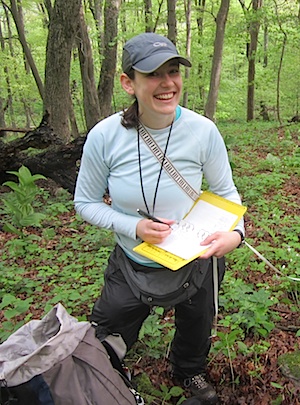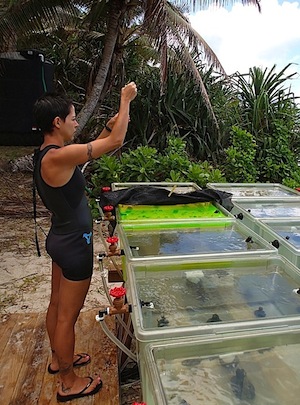Editor's note: Through its George Melendez Wright Climate Change Interns and Fellows program, the National Park Service enables university students to visit national parks to investigate issues related to climate change. Here are two of the studies being investigated by students. Thanks to the Park Service's Climate Change Response Program for making the profiles available.
Salamander Skin At Shenandoah National Park
All animals live in close association with non-harmful bacteria that provide numerous services to the host, including disease protection. The focus of Carly Muletz’s research fellowship is to determine how climate change may alter amphibian skin microbial communities and hostpathogen disease dynamics.

Ms. Muletz's research into salamanders at Shenandoah National Park could lead to better conservation practices for these amphibians. NPS photo.
Studying amphibian skin microbial ecology is critical for understanding how amphibians are protected from skin infections by the fungal pathogen Batrachochytrium dendrobatidis (Bd).
Ms. Muletz, a student at the University of Maryland, is working in the Appalachian Mountains in Shenandoah National Park, a global hotspot of salamander biodiversity. She is sampling the skin of two salamander species, one declining and one non-declining, along an elevation gradient that which will allow her to predict distributional changes in symbiotic bacteria and Bd with changes in temperature.
She is using both traditional culturing methods to identify protective bacteria that inhibit Bd growth and new high-throughput sequencing methods to characterize the entire bacterial community per species.
This research will reveal important ecological interactions on amphibian skin that can be used to identify conservation priorities and guide policy to protect and manage amphibian biodiversity in Shenandoah National Park.
Coral Growth at National Park of American Samoa
For over a decade scientists have been amazed by a coral reef ecosystem off the shore of a small island in the south Pacific because the corals are exposed to variable and sometimes extreme environmental conditions. This coral reef is part of the National Park of American Samoa on Ofu Island.
Lupita Ruiz-Jones, a graduate student in the Biology Department of Stanford University, has been working with members of Dr. Steve Palumbi’s lab to study one of the corals in the genus Acropora found there. As researchers around the world seek to understand the impacts corals will face due to climate change, it has become increasingly apparent that in certain coral reef ecosystems natural environmental variability can span pH and temperature values that are predicted for the future. And as we work towards predicting climate change impacts it may be informative to understand the influence this natural environmental variability has on corals.
In September, Lupita spent four weeks on Ofu (where the primary available fruits are papaya and banana and the population is ~200) working on her fellowship project.

Lupita Ruiz-Jones is studying coral reefs with hopes of discovering how best to manage them in the face of climate change. NPS photo.
The goal of her project is to investigate the influence of natural environmental variability on coral calcification, by comparing the amount of linear growth that occurs during a six-day period of moderate variability to growth that occurs during a six-day period of pH and temperature extremes.
To address this question she used the fluorescent dye Calcein to stain the coral skeleton at the start and end of each growth period. The next step will be to analyze the samples with fluorescence microscopy. The ultimate goal of her work is to help promote the resilience of corals worldwide by identifying effective management actions under increasing acidity and temperatures.
Ms. Ruiz-Jones became interested in coral reefs during her undergraduate studies at Chaminade University of Honolulu and internships at the University of Hawai`i’s Kewalo Marine Lab. Coral reefs are threatened worldwide and Lupita hopes to continue studying these beautiful ecosystems and the organisms that compose them.

 Support Essential Coverage of Essential Places
Support Essential Coverage of Essential Places






